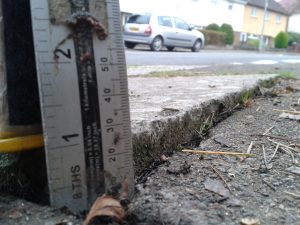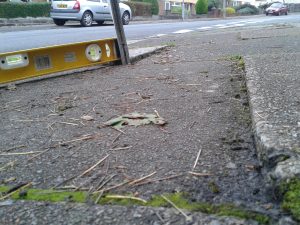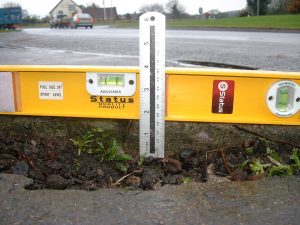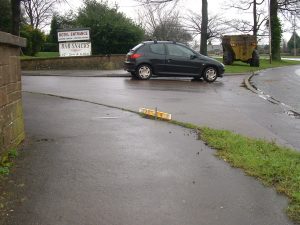What the law says about pavement accident claims
There are some common misconceptions out there as to what merits a valid claim for slip and trip personal injury compensation after a fall on a damaged path or pavement. Many people wrongly believe that any fall in public that leads to injuries (commonly wrist, ankle, foot, knee, hip or ligament injuries) means they can sue the council. The truth however is very different, and to succeed with a claim there are certain criteria that must be met.
Firstly, to make a claim against a local authority or other land owner after a slip, trip or fall, the claimant must demonstrate that the defect (a raised edge, or hole, for example) which lead to their accident met specific size requirements, usually more than 1 inch.
Secondly, anyone looking to succeed with a claim will need to prove that the defendant failed to adequately inspect and maintain the pavements and road within their responsibility, and therefore left a dangerous hazard in situ.
Thirdly, a claimant will need to demonstrate that the hazard that caused them to sustain injury was present for a period of at least 6 months before their accident date.
Local council legal duties to prevent pavement accidents
While councils have a duty of care to prevent pavement accidents, they are understandably given some leeway in terms of how fast they can be expected to fix defects. The courts have stated that landowners and local authorities require ample time to inspect the footpaths and roads in their area, identify and then repair any hazards or faults to reduce the risk of injury to the public.
Any defects found that have a vertical tripping edge of 1″ or more should be listed for repair and removed from the footpath as quickly as possible. If a hazard has been in situ for 6 months or MORE, it should have been highlighted for repair IF the local authority correctly inspected the pavement in question.
In general, councils have the following responsibilities when it comes to roads and pavements:
- To have a system to regularly inspect roads and footpaths for accident risks
- To check busier routes more regularly than less used ones
- To repair any defects within a reasonable time
- To act on any public reports of dangerous surfaces within a reasonable time
- To signpost any hazards or dangers to the public
Failing to uphold these responsibilities could leave a council open to having to pay compensation to anyone injured as a result of their negligence.
Trip hazard height – use photographic evidence to make a claim
To succeed with a claim for compensation for injuries sustained in a pavement accident, it is important to provide clear photographic evidence of the trip hazard height. This will help your solicitor to prove that an alleged 3rd party are liable, that an ‘actionable defect’ was in situ and should have been repaired.
Claimants should ensure that they have taken or obtained photographs of a hazard that caused them to fall BEFORE it is repaired. With most people now having a camera built in to their mobile phones, obtaining evidential photographs is easy and should always be done. To take a good photograph, the height of the defect should be shown against a clear measurement. Most people don’t carry a ruler or measure with them, but a 50p or other coin against the vertical edge of a pothole or raised paving stone makes for a good alternative as it provides something to indicate the size of the hole or raised edge at the centre of the claim.
The hazard shown in the above example is on the acceptable edge of being deemed ‘actionable’ (a hazard likely to succeed in a claim for compensation) although it is borderline. The photographs show clear measurements with the defect just exceeding 25mm/1″ from the surrounding surface level. The location of the defect (in terms of background landmarks) and enabling the direction of travel to be seen further strengthens a claim for tripping accident compensation.
As well as photographs, a strong claim will provide further evidence in the form of:
- Witness contact details
- An accident report noting the location and date
- A medical report on the injuries sustained and treatment required
- Receipts for any expenses incurred
How much compensation do you get for tripping on a pavement?
Compensation payouts depend on injury severity, your financial losses and the impact on your quality of life. Usually we will claim for the following on your behalf:
- The pain and distress caused to you by the injuries sustained
- Associated costs and losses
- Lost earnings if you have been away from work as a result of the accident
- Medical treatments, rehabilitation therapies and post accident care
- Restrictions on your ability to fulfil your usual activities and social life
- The psychological impact of your injury
- Miscellaneous expenses (bus fares, painkillers etc)
There are guidelines issued by the courts for solicitors, but it’s impossible to say exactly how much you can expect as all cases vary. As a guide, some settlement values are listed in the table below for common fall injury claims, this is for the injury only, not including lost wages or expenses, for example:
| Type of injury | Compensation amount |
|---|---|
| Neck injury | £2,000 – £140,000 |
| Minor brain or head injury | £2,070 – £11,980 |
| Finger injury | £4,000 – £85,000 |
| Wrist injury | £3,310 – £44,690 |
| Hip or pelvis injury | £3,710 – £24,950 |
| Fractured forearm | £6,190 – £18,020 |
| Permanent back injury | £11,730 – £26,050 |
| Serious shoulder injury | £11,980 – £18,020 |
| Ankle injury | £12,900 – £46,980 |
How to report your pavement accident to the council
The UK Government website has a handy page where you can find the relevant department of the local council responsible for the area in which you fell. You should report your accident to them, describing the hazard and its location, what injuries you’ve sustained and what medical treatment you have received.
Try to take photographs of the accident site showing the depth or height of the hazard with clear measurements. You could also get the names and contact details of any witnesses, as this will provide further evidence.
Before sending all this in, our best advice is to hire a specialist personal injury solicitor to run your claim, as this will give you the best chance of succeeding.
The evidence you’ll need
In order to win injury compensation, claimants must gather as much evidence as possible to help their solicitor force the council to admit liability.
Medical evidence
If you haven’t had medical treatment, it is likely that your injuries will not be seen as sufficiently serious to warrant a claim for compensation. This is because medical evidence is needed to support your claim. If you have been suffering in silence and haven’t seen the GP, you still can. If the GP is happy to note that your injuries are consistent with those suffered as a result of a trip, for example, you can then prove your injuries and pursue a claim.
Hazard evidence
Even if your injuries are severe, the pavement must still have a vertical tripping edge in excess of 25mm for you to have a valid claim. That’s a fairly easy thing for a claimant to identify when they look at what’s caused their fall, and photographs of the hazard can be taken for proof.
The more complex issue is proving how long the raised flagstone or uneven pavement surface has been there. The claimant needs to demonstrate that the hazard that caused their accident has been in situ for a minimum of 6 months, and sometimes 12 months. So how do you do this?
Witnesses
To greatly increase the strength of your claim, you can obtain witness evidence from local shop keepers, residents or other regular users of a pavement regarding its condition. These people may not have witnessed the claimant’s accident, but instead can be a witness to a hazard being present. They can state where the hazard is, what it is, the rough dimensions of the hazard and how long it has been in situ. If an independent person can state that they have seen the hazard in situ for a minimum of 6 months and sign a statement to that effect, it helps to show that the local authority have either failed to inspect the area or carry out adequate repairs.
For example, if the hazardous pavement is in a residential area, it is likely that the local residents will know how long it has been there for. Furthermore, one of them may have reported it to the council already. As an injured claimant, you should approach these residents and ask if they know about the damaged pavement and how long it has been there. If one of them does, you could ask them if they would be willing to act as a hazard witness.
Most people are more than willing to act as a witness to support a claimant, as this can help to make sure that the local authority speed up their inspection and repair regime.
How to start a no win no fee pavement accident claim
If you can prove council liability and your injuries are severe enough, you will be eligible to claim compensation for them. Our no win, no fee solicitors can claim for the following on your behalf:
- The pain and distress caused to you by your injuries
- Associated costs and losses (special damages)
- Restrictions on your ability to fulfil your usual activities and social life
No win no fee enables you to make a claim without it costing you anything if the claim fails to succeed. If you win, your solicitor gets around 25% of the value of your claim.
Instructing the services of a specialist claims expert is always a good idea to give your claim the best possible chances of success.
At Direct2Compensation we know your rights and how to ensure that any claim for tripping accident compensation is presented in the best possible light. We know how to identify whether a hazard presents a valid claim, and how to ensure that the right evidence is in place to give you the best prospects of succeeding.
If you believe that you have a claim for compensation after a pavement accident, or want to ask about whether or not your injuries will entitle you to claim, you can call us on 01225 430285 or and one of our expert team will be in touch. We’ll only need a few minutes of your time to let you know if you can make a claim and there is no charge for assessing your case.







198 questions have been answered on this subject - ask us your question